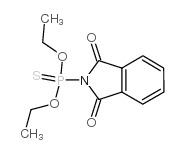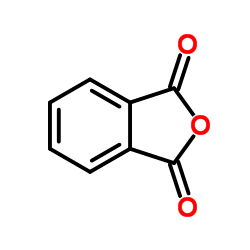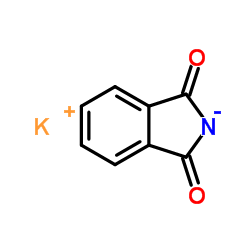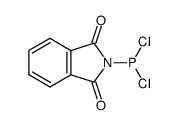5131-24-8
| 中文名 | 灭菌磷 |
|---|---|
| 英文名 | ditalimfos |
| 英文别名 |
O,O-diethyl phthalimidophosphonothioate
EINECS 225-875-8 PLONDREL O,O-diethyl phthalimido-phosphonothioate N-(diethoxyphosphinothioyl)phthalimide Farmil Laptran Millie 0,0-Diethyl-phthalimidophosphonothioat O 199 re199 MFCD00055502 M 2452 O,O-diethyl P-(1,3-dihydro-1,3-dioxo-2H-isoindol-2-yl)phosphonothioate O,O-diethyl (1,3-dioxo-1,3-dihydro-2H-isoindol-2-yl)phosphonothioate 0,0-Diethyl-phthalimidophosphonothionat leucon phthalimido-phosphonothioic acid O,O'-diethyl ester DITALIMFOS sf101 |
| 熔点 | 85-86℃ |
|---|---|
| 分子式 | C12H14NO4PS |
| 分子量 | 299.28300 |
| 闪点 | >100 °C |
| 精确质量 | 299.03800 |
| PSA | 97.74000 |
| LogP | 3.16860 |
| 外观性状 | solid |
| 储存条件 | 4℃ 阴凉干燥处,密封保存 |
| 稳定性 | 常温常压下稳定 |
| 分子结构 | 1、 摩尔折射率:73.81 2、 摩尔体积(m3/mol):216.4 3、 等张比容(90.2K):602.9 4、 表面张力(dyne/cm):60.1 5、 极化率(10 -24cm 3):29.26 |
| 计算化学 | 1.疏水参数计算参考值(XlogP):无 2.氢键供体数量:0 3.氢键受体数量:5 4.可旋转化学键数量:5 5.互变异构体数量:无 6.拓扑分子极性表面积87.9 7.重原子数量:19 8.表面电荷:0 9.复杂度:394 10.同位素原子数量:0 11.确定原子立构中心数量:0 12.不确定原子立构中心数量:0 13.确定化学键立构中心数量:0 14.不确定化学键立构中心数量:0 15.共价键单元数量:1 |
| 更多 | 1. 性状:不确定 2. 密度(g/cm3):不确定 3. 相对蒸汽密度(g/mL,空气=1):不确定 4. 熔点(ºC):不确定 5. 沸点(ºC,常压):不确定 6. 沸点(ºC,25mmHg):不确定 7. 折光率(nD20):不确定 8. 闪点(°F):>100 9. 比旋光度(º, C=1, EtOH):不确定 10. 自燃点或引燃温度(ºC):不确定 11. 蒸气压(kPa,25ºC):不确定 12. 饱和蒸气压(kPa,60ºC):不确定 13. 燃烧热(KJ/mol):不确定 14. 临界温度(ºC):不确定 15. 临界压力(KPa):不确定 16. 油水(辛醇/水)分配系数的对数值:不确定 17. 爆炸上限(%,V/V):不确定 18. 爆炸下限(%,V/V):不确定 19. 溶解性:不确定 |
|
Section1. IDENTIFICATION OF THE SUBSTANCE/MIXTURE Product identifiers Product name: Ditalimfos solution Index-No.: 608-001-00-3 Relevant identified uses of the substance or mixture and uses advised against Identified uses: Laboratory chemicals, Manufacture of substances Section2. HAZARDS IDENTIFICATION Classification of the substance or mixture Classification according to Regulation (EC) No 1272/2008 [EU-GHS/CLP] Flammable liquids (Category 2) Acute toxicity, Oral (Category 4) Acute toxicity, Inhalation (Category 4) Acute toxicity, Dermal (Category 4) Eye irritation (Category 2) Classification according to EU Directives 67/548/EEC or 1999/45/EC Highly flammable. Harmful by inhalation, in contact with skin and if swallowed. Irritating to eyes. Label elements Labelling according Regulation (EC) No 1272/2008 [CLP] Pictogram Signal wordDanger Hazard statement(s) H225Highly flammable liquid and vapour. H302Harmful if swallowed. H312Harmful in contact with skin. H319Causes serious eye irritation. H332Harmful if inhaled. Precautionary statement(s) P210Keep away from heat/sparks/open flames/hot surfaces. - No smoking. P280Wear protective gloves/ protective clothing. P305 + P351 + P338IF IN EYES: Rinse cautiously with water for several minutes. Remove contact lenses, if present and easy to do. Continue rinsing. Supplemental Hazardnone Statements According to European Directive 67/548/EEC as amended. Hazard symbol(s) R-phrase(s) R11Highly flammable. R20/21/22Harmful by inhalation, in contact with skin and if swallowed. R36Irritating to eyes. S-phrase(s) S16Keep away from sources of ignition - No smoking. S36/37Wear suitable protective clothing and gloves. Other hazards - none Section3. COMPOSITION/INFORMATION ON INGREDIENTS Mixtures Formula: C12H14NO4PS Molecular Weight: 299,28 g/mol ComponentClassificationConcentration Acetonitrile CAS-No.75-05-8Flam. Liq. 2; Acute Tox. 4; Eye- EC-No.200-835-2Irrit. 2; H225, H302 + H312 + Index-No.608-001-00-3H332, H319 Registration number01-2119471307-38-XXXX F, Xn, R11 - R20/21/22 - R36 For the full text of the H-Statements and R-Phrases mentioned in this Section, see Section 16 Section4. FIRST AID MEASURES Description of first aid measures General advice Consult a physician. Show this safety data sheet to the doctor in attendance. If inhaled If breathed in, move person into fresh air. If not breathing, give artificial respiration. Consult a physician. In case of skin contact Wash off with soap and plenty of water. Consult a physician. In case of eye contact Rinse thoroughly with plenty of water for at least 15 minutes and consult a physician. If swallowed Do NOT induce vomiting. Never give anything by mouth to an unconscious person. Rinse mouth with water. Consult a physician. Most important symptoms and effects, both acute and delayed Treat as cyanide poisoning., Always have on hand a cyanide first-aid kit, together with proper instructions., The onset of symptoms is generally delayed pending conversion to cyanide., Nausea, Vomiting, Diarrhoea, Headache, Dizziness, Rash, Cyanosis, excitement, depression, Drowsiness, impaired judgment, Lack of coordination, stupor, death Indication of any immediate medical attention and special treatment needed no data available Section5. FIREFIGHTING MEASURES Extinguishing media Suitable extinguishing media Use water spray, alcohol-resistant foam, dry chemical or carbon dioxide. Special hazards arising from the substance or mixture Carbon oxides, nitrogen oxides (NOx) Advice for firefighters Wear self contained breathing apparatus for fire fighting if necessary. Further information Use water spray to cool unopened containers. Section6. ACCIDENTAL RELEASE MEASURES Personal precautions, protective equipment and emergency procedures Use personal protective equipment. Avoid breathing vapors, mist or gas. Ensure adequate ventilation. Remove all sources of ignition. Evacuate personnel to safe areas. Beware of vapours accumulating to form explosive concentrations. Vapours can accumulate in low areas. Environmental precautions Prevent further leakage or spillage if safe to do so. Do not let product enter drains. Methods and materials for containment and cleaning up Contain spillage, and then collect with an electrically protected vacuum cleaner or by wet-brushing and place in container for disposal according to local regulations (see section 13). Reference to other sections For disposal see section 13. Section7. HANDLING AND STORAGE Precautions for safe handling Avoid contact with skin and eyes. Avoid inhalation of vapour or mist. Keep away from sources of ignition - No smoking.Take measures to prevent the build up of electrostatic charge. Conditions for safe storage, including any incompatibilities Store in cool place. Keep container tightly closed in a dry and well-ventilated place. Containers which are opened must be carefully resealed and kept upright to prevent leakage. Recommended storage temperature: 2 - 8 °C Specific end uses no data available Section8. EXPOSURE CONTROLS/PERSONAL PROTECTION Control parameters Components with workplace control parameters Exposure controls Appropriate engineering controls Handle in accordance with good industrial hygiene and safety practice. Wash hands before breaks and at the end of workday. Personal protective equipment Eye/face protection Tightly fitting safety goggles. Faceshield (8-inch minimum). Use equipment for eye protection tested and approved under appropriate government standards such as NIOSH (US) or EN 166(EU). Skin protection Handle with gloves. Gloves must be inspected prior to use. Use proper glove removal technique (without touching glove's outer surface) to avoid skin contact with this product. Dispose of contaminated gloves after use in accordance with applicable laws and good laboratory practices. Wash and dry hands. The selected protective gloves have to satisfy the specifications of EU Directive 89/686/EEC and the standard EN 374 derived from it. Body Protection Complete suit protecting against chemicals, Flame retardant antistatic protective clothing, The type of protective equipment must be selected according to the concentration and amount of the dangerous substance at the specific workplace. Respiratory protection Where risk assessment shows air-purifying respirators are appropriate use a full-face respirator with multi-purpose combination (US) or type ABEK (EN 14387) respirator cartridges as a backup to engineering controls. If the respirator is the sole means of protection, use a full-face supplied air respirator. Use respirators and components tested and approved under appropriate government standards such as NIOSH (US) or CEN (EU). Section9. PHYSICAL AND CHEMICAL PROPERTIES Information on basic physical and chemical properties a) AppearanceForm: clear Colour: colourless b) Odouracetone-like c) Odour Thresholdno data available d) pHno data available e) Melting point/freezingno data available point f) Initial boiling point and 81,0 - 82,0 °C boiling range g) Flash pointno data available h) Evaporation rateno data available i) Flammability (solid, gas) no data available j) Upper/lowerUpper explosion limit: 16 %(V) flammability orLower explosion limit: 4,4 %(V) explosive limits k) Vapour pressure97,1 hPa at 20 °C l) Vapour densityno data available m) Relative density0,78 g/cm3 at 20 °C n) Water solubilitysoluble o) Partition coefficient: n- log Pow: -0,34 octanol/water p) Autoignitionno data available temperature q) Decompositionno data available temperature r) Viscosityno data available s) Explosive propertiesno data available t) Oxidizing propertiesno data available Other safety information no data available Section10. STABILITY AND REACTIVITY Reactivity no data available Chemical stability no data available Possibility of hazardous reactions no data available Conditions to avoid Heat, flames and sparks. Extremes of temperature and direct sunlight. Incompatible materials Acids, Bases, Oxidizing agents, Reducing agents, Alkali metals Hazardous decomposition products Other decomposition products - no data available Section11. TOXICOLOGICAL INFORMATION Information on toxicological effects Acute toxicity LD50 Oral - rat - 2.460 mg/kg LC50 Inhalation - rat - 8 h - 7551 ppm Remarks: Behavioral:Altered sleep time (including change in righting reflex). Behavioral:Convulsions or effect on seizure threshold. Blood: Hemorrhage. LD50 Dermal - rabbit - 2.000 mg/kg Skin corrosion/irritation Skin - rabbit - Mild skin irritation Serious eye damage/eye irritation Eyes - rabbit - Irritating to eyes. Respiratory or skin sensitization Did not cause sensitization on laboratory animals. Germ cell mutagenicity no data available Carcinogenicity no data available IARC:No component of this product present at levels greater than or equal to 0.1% is identified as probable, possible or confirmed human carcinogen by IARC. Reproductive toxicity no data available no data available Specific target organ toxicity - single exposure no data available Specific target organ toxicity - repeated exposure no data available Aspiration hazard no data available Potential health effects InhalationHarmful if inhaled. May cause respiratory tract irritation. IngestionHarmful if swallowed. Skin Harmful if absorbed through skin. May cause skin irritation. EyesCauses eye burns. Signs and Symptoms of Exposure Treat as cyanide poisoning., Always have on hand a cyanide first-aid kit, together with proper instructions., The onset of symptoms is generally delayed pending conversion to cyanide., Nausea, Vomiting, Diarrhoea, Headache, Dizziness, Rash, Cyanosis, excitement, depression, Drowsiness, impaired judgment, Lack of coordination, stupor, death Additional Information RTECS: Not available Section12. ECOLOGICAL INFORMATION Toxicity Toxicity to fishLC50 - Pimephales promelas (fathead minnow) - 1.640,00 mg/l - 96 h Toxicity to daphnia and EC50 - Daphnia magna (Water flea) - 3.600,00 mg/l - 48 h other aquatic invertebrates NOEC - Daphnia magna (Water flea) - 640 mg/l - 14 d Persistence and degradability no data available Bioaccumulative potential no data available Mobility in soil no data available Results of PBT and vPvB assessment no data available Other adverse effects no data available Section13. DISPOSAL CONSIDERATIONS Waste treatment methods Product Burn in a chemical incinerator equipped with an afterburner and scrubber but exert extra care in igniting as this material is highly flammable. Offer surplus and non-recyclable solutions to a licensed disposal company. Contaminated packaging Dispose of as unused product. Section14. TRANSPORT INFORMATION UN number ADR/RID: 1648IMDG: 1648IATA: 1648 UN proper shipping name ADR/RID: ACETONITRILE, SOLUTION IMDG: ACETONITRILE, SOLUTION IATA:Acetonitrile, SOLUTION Transport hazard class(es) ADR/RID: 3IMDG: 3IATA: 3 Packaging group ADR/RID: IIIMDG: IIIATA: II Environmental hazards ADR/RID: noIMDG Marine pollutant: noIATA: no Special precautions for user no data available Section15. REGULATORY INFORMATION This safety datasheet complies with the requirements of Regulation (EC) No. 1907/2006. Safety, health and environmental regulations/legislation specific for the substance or mixture no data available Chemical Safety Assessment no data available Section16. OTHER INFORMATION Text of H-code(s) and R-phrase(s) mentioned in Section 3 Acute Tox.Acute toxicity Eye Irrit.Eye irritation Flam. Liq.Flammable liquids H225Highly flammable liquid and vapour. H302 + H312 +Harmful if swallowed, in contact with skin or if inhaled H332 H319Causes serious eye irritation. FHighly flammable XnHarmful R11Highly flammable. R20/21/22Harmful by inhalation, in contact with skin and if swallowed. R36Irritating to eyes. Further information Copyright 2012 Co. LLC. License granted to make unlimited paper copies for internal use only. The above information is believed to be correct but does not purport to be all inclusive and shall be used only as a guide. The information in this document is based on the present state of our knowledge and is applicable to the product with regard to appropriate safety precautions. It does not represent any guarantee of the properties of the product. Corporation and its Affiliates shall not be held liable for any damage resulting from handling or from contact with the above product. See and/or the reverse side of invoice or packing slip for additional terms and conditions of sale. |
|
毒理学数据: 1、急性毒性:大鼠口径LD50:4930 mg/kg;大鼠LD50: 5gm /kg;兔子口径LD50: 1 gm /kg;兔子皮肤LD50: 1 gm /kg;豚鼠口径LD50:5660mg/kg;小鸡口径LD50:4500mg/kg;鸭口径LD50:>17400mg/kg 生态学数据: 燃烧产生有毒氮氧化物、硫氧化物和磷氧化物气体 CHEMICAL IDENTIFICATION
HEALTH HAZARD DATAACUTE TOXICITY DATA
|
| 符号 |

GHS07 |
|---|---|
| 信号词 | Warning |
| 危害声明 | H315-H317 |
| 警示性声明 | P280 |
| 个人防护装备 | dust mask type N95 (US);Eyeshields;Faceshields;Gloves |
| 危害码 (欧洲) | Xi |
| 风险声明 (欧洲) | 38-43 |
| 安全声明 (欧洲) | 36/37 |
| 危险品运输编码 | UN 2811 6.1/PG 3 |
| RTECS号 | TB2050000 |
| 海关编码 | 2933790020 |
|
~20% 
5131-24-8 |
| 文献:Dow Chemical Company Limited Patent: US4204996 A1, 1980 ; |
|
~% 
5131-24-8 |
| 文献:Shaikhiev; Fridland; Mukhutdinova Russian Journal of General Chemistry, 1999 , vol. 69, # 4 p. 557 - 559 |
|
~% 
5131-24-8 |
| 文献:Shaikhiev; Fridland; Mukhutdinova Russian Journal of General Chemistry, 1999 , vol. 69, # 4 p. 557 - 559 |
| 上游产品 4 | |
|---|---|
| 下游产品 4 | |
| 海关编码 | 2933790020 |
|---|---|
| 中文概述 | 2933790020 灭菌磷,螺虫酰胺。监管条件:S(进出口农药登记证明)。增值税率:17.0%。退税率:9.0%。最低关税:9.0%。普通关税:20.0% |
| 申报要素 | 品名, 成分含量, 用途, 乌洛托品请注明外观, 6-己内酰胺请注明外观, 签约日期 |
| 监管条件 | S.进出口农药登记证明 |
| Summary | 2933790020 o,o-diethyl (1,3-dioxoisoindolin-2-yl)phosphonothioate。supervision conditions:s(import or export registration certificate for pesticides)。VAT:17.0%。tax rebate rate:9.0%。MFN tarrif:9.0%。general tariff:20.0% |









![1-[2-(2-chlorophenoxy)acetyl]piperidine-4-carboxamide结构式](https://image.chemsrc.com/caspic/224/5857-62-5.png)